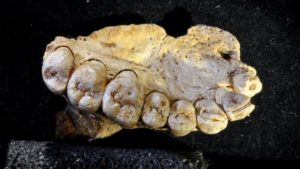Out of Africa – earlier than we thought
 A fossil discovered in Israel could date human migration out of Africa to 190,000 years ago, 70,000 years earlier than previously thought.
A fossil discovered in Israel could date human migration out of Africa to 190,000 years ago, 70,000 years earlier than previously thought.
The find, the oldest of a modern human outside Africa’ is evidence that humans first migrated out of the continent much earlier than previously believed.
Archaeologists digging in a cave called Misliya on the slopes of Mount Carmel on the northern coast of Israel say they believe it had been occupied for several hundred thousand years.
Mina Weinstein-Evron, who led the dig said, the cave had been occupied for several hundred thousand years.
“The cave is one of a series of prehistoric caves. It’s a collapsed cave, but people lived there before it collapsed,” said Ms Weinststein-Evron, of Haifa University.
She said the archaeological evidence suggested that the ancient people who lived in the cave were hunter-gatherers.
“They were hunting animals, mainly ungulates, like fallow dear, gazelle, aurochs (an extinct species of wild cattle) and other small animals,” Ms Weinstein-Evron said.
“They built fireplaces throughout the length of the cave, again and again, in the same place, in the same sort of defined arrangement.”
They made their stone tools using a technique called Levallois, or flint knapping, which originated in Africa at least 300,000 years ago and is known to have been used by both humans and Neanderthals.
Ms Weinstein-Evron said she and her team wanted to find out which species of ancient humans lived in the cave. So, she says, they kept digging.
“And among the animal bones and flint tools we found a jawbone, an upper jawbone of an individual,” she said.
It was the upper left jaw, with parts of the nasal cavity and cheekbone still intact. And it looked remarkably similar to that of modern humans, she said.
“It really is like us. … It’s like you and me,” Ms Weinstein-Evron said.
The fossil also had intact teeth.
A detailed analysis of the jawbone and the teeth confirmed it to a Homo Sapien and it was dated to between 177,000 and 194,000 years old, making it the oldest human fossil outside Africa.
The find was reported in the journal Science.
What this new finding shows is that there were many waves of migration out of Africa starting very early in our evolutionary history.
Rick Potts, a paleoanthropologist at the Smithsonian Museum of Natural History says the find indicates that there were times when Homo sapiens populations seeped out of Africa.
“Groups of humans were probably exploring at different times, looking over the next hill and down into the next valley,” he said.
“They were probably exploring new frontiers based on local ecological conditions. They didn’t have maps. They didn’t know where they were going, whether they were in Africa or wherever,” Dr Potts said.
“They were just following perhaps where the game was good, and food resources were good for eating, there was water.”
But these explorations were likely a process of colonization that failed, he said.
There is little evidence for these early humans being part of our gene pool outside of Africa. This means these groups, including the group in Misliya cave, probably died off at some point.
Genetic evidence suggests humans alive today have descended from a group of humans who left Africa about 60,000 years ago.
Laurie Nowell
AMES Australia Senior Journalist












